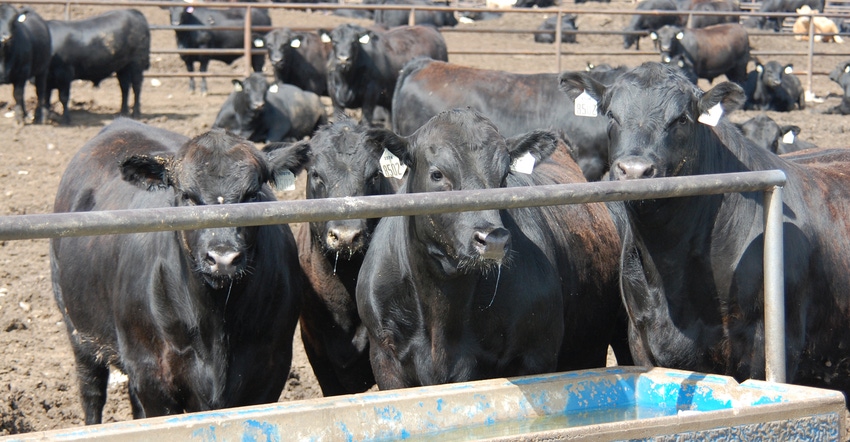
With the stress of drought conditions, low cattle prices and fluctuating commodity prices, it is difficult to make a living in agriculture. Cattle producers themselves can’t afford to lose any performance of their stock, and that includes keeping one disease in particular at bay.
Bovine respiratory disease accounts for approximately 75% of feedlot illnesses and 50% of feedlot deaths. These numbers mean lost productivity, as well as increased labor and medical costs to treat the cattle proving the economic impact of BRD to be devastating.
Cattle have built-in stressors, such as environment, pen and pasture transition and feed changes, that can compromise their health. The most critical time for disease detection seems to be the first 30 days after weaning or receiving cattle. During this time, it is important to reduce stress factors and keep a close watch on cattle.
Che Trejo is a beef technical service veterinarian for Zoetis, and covers the U.S. east of the Rocky Mountains. He spent 15 years in veterinary practice in Mississippi and Oklahoma and watched how ranchers worked with and around BRD. Today, Trejo says more than 1 million calves in the U.S. die from BRD each year, a disease that can be prevented and treated.
When a calf or cow is infected with BRD it will have limited respiratory capacity, and this stress will correlate to other health factors. Properly timed vaccines are the answer. Appropriate prevention allows reduced treatments and death loss associated with BRD.
Zoetis offers a vaccine called Inforce 3, an intranasal vaccine that offers protection against BRSV, IBR and PI3. When used concurrently with an injectable vaccine, One Shot BVD, it provides protection against bovine viral diarrhea as well as from the leading viral and bacterial respiratory pathogens that cause pneumonia.
Typically, the first respiratory vaccinations are given at branding, when the calves are 60-90 days old. Inforce and Oneshot BVD are an excellent choice for the first vaccination a calf receives, regardless of age. The second or "booster" vaccine would be better timed if given 3 weeks ahead of weaning. This allows the calf to be in a lower stress environment and respond more appropriately to vaccination. Bovi-Shield Gold Oneshot would be the vaccine to reach for at this stage of the calf’s life.
Ranchers are very conscientious; it can be hard to bring cattle in and give vaccines then keep calves around until weaning time. It’s more of a logistical problem than anything. However, if you do these protocols, give two rounds of vaccinations preweaning and follow Select Vac guidelines, you can reduce BRD risk four-fold.
"We can really address the increasing pressures against antibiotic use in animal ag," Trejo says. "By focusing on prevention, whether it’s two rounds preweaning, or one at preweaning and one at weaning, we just need to ensure the vaccine is given at the appropriate times."
Contrary to some beliefs, Trejo says weaning is not the ideal time to give a vaccine. A stressful event means the animal does not respond as well. But, he adds, it is better than not giving a dose of BRD vaccine at all.
"It’s also best to deworm at that time," he says. "You’ll get a big return on investment if you give an injectable dectomax at pre-weaning."
The importance of BRD prevention can be quantified in total dollar numbers. Trejo says one million head affected by BRD can correlate to $1 billion impact on the beef industry.
"A billion with a ‘B’ is a hard number to grasp," Trejo says. "And if you break it down to the 40 head or more cow-calf operations, that’s just over a $2,135 loss per ranch."
Any veterinarian or animal health expert I’ve ever interviewed has mentioned the significance of working with a veterinarian on a vaccination strategy. The primary disease in cow herds is BVD. Trejo says national surveys show 8% of all U.S. cow herds have BVD persistent infections. In addition, of the 400,000 ranches Trejo watches data for, the loss reports state 31% of those losses are respiratory related.
"There are two basic vaccines, killed and modified live. Modified live provides superior BVD protection for sure, but you have to work with a vet to manage that vaccine in cow herd," Trejo says. "Killed vaccines are variable in protection against BVD. We have learned in the last several years after priming replacement heifers with Bovi-Shield Gold FP, with two doses pre-breeding can have long-term positive effects and later we have the flexibility to switch to a killed BVD vaccine like CattleMaster Gold FP."
Bulls can be vaccinated just like the cows, and Trejo says treating them is just as important or more. One round of Bovi-Shield Gold FP is good, on an annual basis. Any time the bull is already in the chute, Trejo says to go ahead and vaccinate before breeding season.
Bottom line, BRD is universal. It typically occurs when weather patterns change and forage quality is poor. In the western U.S. a lack of minerals also can contribute to BRD.
Early treatment is key. Like any disease, prevention matters most. Don’t skip the step that can help keep your cows and calves in the best condition possible to help make up for any other environmental or trade floor factors that could otherwise decrease your profitability.
About the Author(s)
You May Also Like




